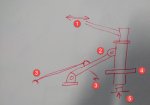- 1,814
- 1,522
- 113
- Location
- Orlando, FL
We aren't really talking about a problem orders of magnitude more difficult. The engine weighs roughly the same as the max lift capacity of the GI issue material handling crane, it's just going to be a few feet further away. My idea is something like this...Are these beds aluminum? You might want to think twice about this.
Whats the load weigh and at what length from the pivot point and how far from the bed floor? Its amazing how much stress a lever with a weight on it introduces.
Please be cautious!

1. Crane needs to have length adjustability while loaded, in order to position an engine. I have some ideas about this, but haven't totally figured it out yet.
2. The crane would have removable outriggers. These wouldn't typically be necessary, but for the specific case of lifting the engine would increase the capacity significantly. You can have two of these in the bed, one along the length of the bed and the other across. That means that the outrigger must take compression load when the crane is above it, and tension load when the crane is pointed away (on the opposite side). For example, lifting the engine with the crane pointed to the front of the truck puts the rear outrigger in tension, but then you swing the engine to the outside and it puts the side outrigger in tension. If the loads I'm lifting in on a particular day don't require them, I just don't put the outriggers on.
3. Without drilling the outriggers into the bed, you can ratchet strap or turnbuckle them to the d-rings on the bed floor. They have to be tied down in to places, in order to support both the compression and tension scenarios.
4. Use an extra wide base plate, that is as wide as possible but still able to fit in all 4 post locations in the bed. The base plate may not be symmetric in order to give maximum capacity in certain directions. Steel plate is cheap (in context), so if necessary I could just add a huge (e.g. 3' square) steel plate that temporarily bolts to the base plate of the crane.
5. Design a cap, which may include a "spider" that can reach up and press against the bottom of the bed in all 4 locations in the bed. After the crane is in place, the cap is installed from underneath the bed. This helps keep the crane from tilting, and helps spread the contact points out to more surface area.
UPDATE: While I was posting, I saw this. Looks like other people had my "outriggers" idea too.
Also I think adding a chain from the mid-section of the crane to the bed hook would be a good idea for extra support while lifting heavy items.
Last edited:


